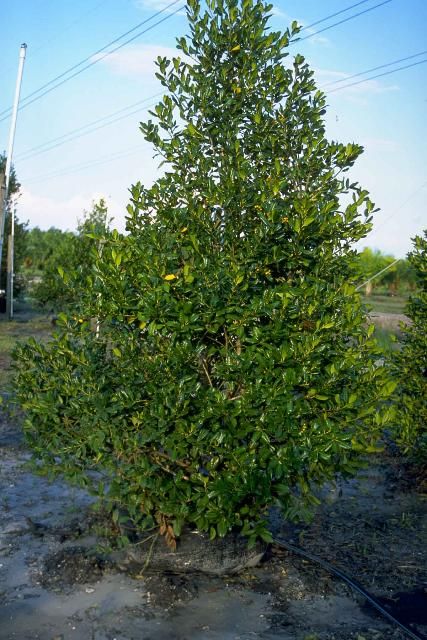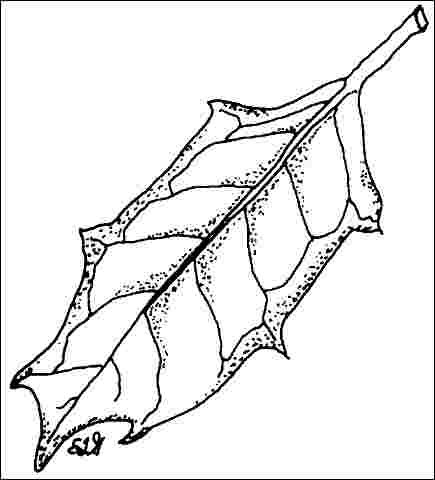Introduction
A hybrid between Ilex aquifolium and Ilex cornuta , Nellie R. Stevens Holly has kept the best traits of both parents, with lustrous, dark green leaves and abundant fruit production. Leaves are among the darkest of any plant. Vigorous and fast-growing, this Holly quickly grows into an attractive, broad pyramidally-shaped evergreen, 20 to 30 feet high and 10 to 12 feet wide. It will need a male Holly nearby to ensure pollination and production of the vivid red berries. Chinese Holly, Ilex cornuta will flower at the proper time and may be used for this purpose.

Credit: Ed Gilman
General Information
Scientific name: Ilex x
Pronunciation: EYE-lecks
Common name(s): 'Nellie R. Stevens' Holly
Family: Aquifoliaceae
USDA hardiness zones: 6A through 9B (Fig. 2)
Origin: not native to North America
Invasive potential: little invasive potential
Uses: sidewalk cutout (tree pit); parking lot island < 100 sq ft; parking lot island 100-200 sq ft; parking lot island > 200 sq ft; tree lawn 3-4 feet wide; tree lawn 4-6 feet wide; tree lawn > 6 ft wide; street without sidewalk; screen; hedge; urban tolerant; highway median; container or planter; Christmas tree
Availability: not native to North America

Description
Height: 20 to 30 feet
Spread: 10 to 15 feet
Crown uniformity: symmetrical
Crown shape: pyramidal, oval, upright/erect
Crown density: dense
Growth rate: moderate
Texture: medium
Foliage
Leaf arrangement: alternate (Fig. 3)
Leaf type: simple
Leaf margin: entire, pectinate, spiny
Leaf shape: oblong
Leaf venation: brachidodrome, pinnate
Leaf type and persistence: evergreen
Leaf blade length: 2 to 4 inches
Leaf color: green
Fall color: no color change
Fall characteristic: not showy

Flower
Flower color: white/cream/gray
Flower characteristics: not showy
Fruit
Fruit shape: round
Fruit length: less than .5 inch
Fruit covering: fleshy
Fruit color: red
Fruit characteristics: does not attract wildlife; showy; fruit/leaves not a litter problem
Trunk and Branches
Trunk/bark/branches: branches droop; not showy; typically multi-trunked; thorns
Pruning requirement: little required
Breakage: resistant
Current year twig color: green
Current year twig thickness: medium
Wood specific gravity: unknown
Culture
Light requirement: full sun, partial sun or partial shade
Soil tolerances: clay; sand; loam; acidic; slightly alkaline; well-drained; extended flooding
Drought tolerance: high
Aerosol salt tolerance: unknown
Other
Roots: not a problem
Winter interest: no
Outstanding tree: no
Ozone sensitivity: unknown
Verticillium wilt susceptibility: resistant
Pest resistance: free of serious pests and diseases
Use and Management
Nellie R. Stevens Holly is one of the best Hollies for the warmer regions of the country, and is ideally-suited for use as a screen or border. It maintains a nice, uniform shape without pruning. It is now becoming widely available and is one of the best plants for making a screen due to its very dense, symmetrical habit. Locate it where it will have enough space to spread since trees become wide at the base. Lower branches can be removed to create a clear trunk for planting along a walk or near a patio, but the tree really shines as a specimen or screen allowed to develop with all branches intact to the ground. Nursery operators grow the tree either as a multi-stemmed clump or with one central leader. Multi-stemmed trees may not hold up in ice storms as well as those with a central leader. Main branches on single-leadered trees are usually well-secured to the trunk, making the tree sturdy and a permanent fixture for almost any landscape.
Nellie R. Stevens Holly should be grown in full sun or partial shade on well-drained, slightly acid soil. Plants are drought-resistant once established.
Propagation is by cuttings or grafting.
Pests and Diseases
No pests or diseases are of major concern, perhaps scale on occasion.